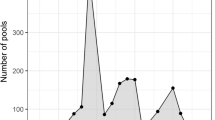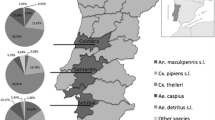Abstract
Dirofilaria repens is a parasite of animals and humans, transferred by mosquitoes. The assessment of the presence of D. repens-infected vertebrate hosts in the investigated area can be performed by xenomonitoring—detection of the parasite in blood-feeding arthropods. Our study aimed to evaluate PCR xenomonitoring of mosquitoes as a tool for dirofilariosis surveillance in Poland. We were also interested whether inter-study comparisons at the international level would be possible. Mosquitoes were collected in a single locality in Mazowsze province in Poland, in which between 12 and 20 % of dogs were infected with D. repens and autochthonous human dirofilariosis was confirmed. All captured female mosquitoes were divided into pools; alternatively, single mosquitoes were analyzed; DNA was isolated and subjected to PCR and real-time PCR for detection of D. repens. The estimations of infection rates of mosquitoes with D. repens, based on PCR results, varied from 0 to 1.57 % even between assays for detection of distinct fragments of the same marker—cytochrome oxidase subunit one gene. Polymorphisms of the DNA sequence within binding sites of the primers used in D. repens xenomonitoring assays, applied in European studies, were identified. Non-specific amplification of Setaria tundra (Nematoda: Onchocercidae) DNA occurred. Surveillance of dirofilariosis by PCR mosquito xenomonitoring is possible; however, the efficiency of the approach on territories where the prevalence of the disease among definitive hosts is lower than 12 % remains unknown. Furthermore, mosquito infection rate estimations can be PCR assay dependent, which makes inter-study comparisons difficult. The results obtained in independent European xenomonitoring studies were contradictory. International collaboration would be required to establish a standardized set of assays for sensitive and specific xenomonitoring-based dirofilariosis surveillance.





Similar content being viewed by others
References
Anderson RC (2000) Nematode parasites of vertebrates: their development and transmission, 2nd edn. CABI Publishing, Wallingford; New York, p 650. doi:10.1079/9780851994215.0000
Antolová D, Miterpáková M, Paraličová Z (2015) Case of human Dirofilaria repens infection manifested by cutaneous larva migrans syndrome. Parasitol Res 114(8):2969–2973. doi:10.1007/s00436-015-4499-7
Bocková E, Rudolf I, Kočišová A, Betášová L, Venclíková K, Mendel J, Hubálek Z (2013) Dirofilaria repens microfilariae in Aedes vexans mosquitoes in Slovakia. Parasitol Res 112(10):3465–3470. doi:10.1007/s00436-013-3526-9
Boom R, Sol C, Beld M, Weel J, Goudsmit J, Wertheim-van Dillen P (1999) Improved silica-guanidiniumthiocyanate DNA isolation procedure based on selective binding of bovine alpha-casein to silica particles. J Clin Microbiol 37(3):615–619
Boom R, Sol CJ, Salimans MM, Jansen CL, Wertheim-van Dillen PM, van der Noordaa J (1990) Rapid and simple method for purification of nucleic acids. J Clin Microbiol 28(3):495–503
Boyle B, Dallaire N, MacKay J (2009) Evaluation of the impact of single nucleotide polymorphisms and primer mismatches on quantitative PCR. BMC Biotechnol 9:75. doi:10.1186/1472-6750-9-75
Cancrini G, Magi M, Gabrielli S, Arispici M, Tolari F, Dell’Omodarme M, Prati MC (2006) Natural vectors of dirofilariasis in rural and urban areas of the Tuscan region, central Italy. J Med Entomol 43(3):574–579
Cielecka D, Żarnowska-Prymek H, Masny A, Salamatin R, Wesołowska M, Gołąb E (2012) Human dirofilariosis in Poland: the first cases of autochthonous infections with Dirofilaria repens. Ann Agric Environ Med 19(3):445–450
Cowling DW, Gardner IA, Johnson WO (1999) Comparison of methods for estimation of individual-level prevalence based on pooled samples. Prev Vet Med 39(3):211–225
Czajka C, Becker N, Jöst H, Poppert S, Schmidt-Chanasit J, Krüger A, Tannich E (2014) Stable transmission of Dirofilaria repens nematodes, northern Germany. Emerg Infect Dis 20(2):328–331. doi:10.3201/eid2002.131003
Czajka C, Becker N, Poppert S, Jöst H, Schmidt-Chanasit J, Krüger A (2012) Molecular detection of Setaria tundra (Nematoda: Filarioidea) and an unidentified filarial species in mosquitoes in Germany. Parasit Vectors 5:14. doi:10.1186/1756-3305-5-14
Demiaszkiewicz AW, Polańczyk G, Pyziel AM, Kuligowska I, Lachowicz J (2009) The first foci of dirofilariosis of dogs evoked by Dirofilaria repens Railliet et Henry, 1911 in central Poland. Wiad Parazytol 55(4):367–370 (in Polish)
Erickson SM, Fischer K, Weil GJ, Christensen BM, Fischer PU (2009) Distribution of Brugia malayi larvae and DNA in vector and non-vector mosquitoes: implications for molecular diagnostics. Parasit Vectors 2(1):56. doi:10.1186/1756-3305-2-56
Ferreira CAC, de Pinho Mixão V, Novo MTLM, Calado MMP, Gonçalves LAP, Belo SMD, de Almeida APG (2015) First molecular identification of mosquito vectors of Dirofilaria immitis in continental Portugal. Parasit Vectors 8:139. doi:10.1186/s13071-015-0760-2
Hamel D, Silaghi C, Zapadynska S, Kudrin A, Pfister K (2013) Vector-borne pathogens in ticks and EDTA-blood samples collected from client-owned dogs, Kiev, Ukraine. Ticks Tick Borne Dis 4(1/2):152–155. doi:10.1016/j.ttbdis.2012.08.005
Harizanov RN, Jordanova DP, Bikov IS (2014) Some aspects of the epidemiology, clinical manifestations, and diagnosis of human dirofilariasis caused by Dirofilaria repens. Parasitol Res 113(4):1571–1579. doi:10.1007/s00436-014-3802-3
Katholi CR, Toé L, Merriweather A, Unnasch TR (1995) Determining the prevalence of Onchocerca volvulus infection in vector populations by polymerase chain reaction screening of pools of black flies. J Infect Dis 172(5):1414–1417
Kronefeld M, Kampen H, Sassnau R, Werner D (2014) Molecular detection of Dirofilaria immitis, Dirofilaria repens and Setaria tundra in mosquitoes from Germany. Parasit Vectors 7:30. doi:10.1186/1756-3305-7-30
Latrofa MS, Montarsi F, Ciocchetta S, Annoscia G, Dantas-Torres F, Ravagnan S, Capelli G, Otranto D (2012a) Molecular xenomonitoring of Dirofilaria immitis and Dirofilaria repens in mosquitoes from north-eastern Italy by real-time PCR coupled with melting curve analysis. Parasit Vectors 5:76. doi:10.1186/1756-3305-5-76
Latrofa MS, Dantas-Torres F, Annoscia G, Genchi M, Traversa D, Otranto D (2012b) A duplex real-time polymerase chain reaction assay for the detection of and differentiation between Dirofilaria immitis and Dirofilaria repens in dogs and mosquitoes. Vet Parasitol 185(2/4):181–185. doi:10.1016/j.vetpar.2011.10.038
Martins EM, Vilarinho L, Esteves S, Lopes-Marques M, Amorim A, Azevedo L (2011) Consequences of primer binding-sites polymorphisms on genotyping practice. Open J Genet 1(2):15–17. doi:10.4236/ojgen.2011.12004
Masny A, Lewin T, Salamatin R, Golab E (2011) The first report on detection of canine Acanthocheilonema reconditum in Poland and the associated diagnostic problems. Pol J Vet Sci 14(3):485–487
Morales-Hojas R, Cheke RA, Post RJ (2006) Molecular systematics of five Onchocerca species (Nematoda: Filarioidea) including the human parasite, O. volvulus, suggest sympatric speciation. J Helminthol 80(3):281–290
Osińska B, Demiaszkiewicz AW, Pyziel AM, Kuligowska J, Lachowicz J, Dolka I (2014) Prevalence of Dirofilaria repens in dogs in central-eastern Poland and histopathological changes caused by this infection. Bull Vet Inst Pulawy 58(1):35–39. doi:10.2478/bvip-2014-0006
Pantchev N, Norden N, Lorentzen L, Rossi M, Rossi U, Brand B, Dyachenko V (2009) Current surveys on the prevalence and distribution of Dirofilaria spp. in dogs in Germany. Parasitol Res 105(Suppl 1):S63–S74. doi:10.1007/s00436-009-1497-7
Quinlan AR, Marth GT (2007) Primer-site SNPs mask mutations. Nat Methods 4(3):192. doi:10.1038/nmeth0307-192
Rishniw M, Barr SC, Simpson KW, Frongillo MF, Franz M, Dominguez Alpizar JL (2006) Discrimination between six species of canine microfilariae by a single polymerase chain reaction. Vet Parasitol 135(3/4):303–314. doi:10.1016/j.vetpar.2005.10.013
Rudolf I, Šebesta O, Mendel J, Betášová L, Bocková E, Jedličková P, Venclíková K, Blažejová H, Šikutová S, Hubálek Z (2014) Zoonotic Dirofilaria repens (Nematoda: Filarioidea) in Aedes vexans mosquitoes, Czech Republic. Parasitol Res 113(12):4663–4667. doi:10.1007/s00436-014-4191-3
Saah AJ, Hoover DR (1997) “Sensitivity” and “specificity” reconsidered: the meaning of these terms in analytical and diagnostic settings. Ann Intern Med 126(1):91–94
Sałamatin RV, Pavlikovska TM, Sagach OS, Nikolayenko SM, Kornyushin VV, Kharchenko VO, Masny A, Cielecka D, Konieczna-Sałamatin J, Conn DB, Golab E (2013) Human dirofilariasis due to Dirofilaria repens in Ukraine, an emergent zoonosis: epidemiological report of 1465 cases. Acta Parasitol 58(4):592–598. doi:10.2478/s11686-013-0187-x
Sassnau R, Kohn M, Demeler J, Kohn B, Müller E, Krücken J, von Samson-Himmelstjerna G (2013) Is Dirofilaria repens endemic in the Havelland district in Brandenburg, Germany? Vector Borne Zoonotic Dis 13(12):888–891. doi:10.1089/vbz.2012.1293
Silbermayr K, Eigner B, Joachim A, Duscher GG, Seidel B, Allerberger F, Indra A, Hufnagl P, Fuehrer HP (2014) Autochthonous Dirofilaria repens in Austria. Parasit Vectors 7:226. doi:10.1186/1756-3305-7-226
Simón F, Siles-Lucas M, Morchón R, González-Miguel J, Mellado I, Carretón E, Montoya-Alonso JA (2012) Human and animal dirofilariasis: the emergence of a zoonotic mosaic. Clin Microbiol Rev 25(3):507–544. doi:10.1128/cmr.00012-12
Thanchomnang T, Intapan PM, Tantrawatpan C, Lulitanond V, Chungpivat S, Taweethavonsawat P, Kaewkong W, Sanpool O, Janwan P, Choochote W, Maleewong W (2013) Rapid detection and identification of Wuchereria bancrofti, Brugia malayi, B. pahangi, and Dirofilaria immitis in mosquito vectors and blood samples by high resolution melting real-time PCR. Korean J Parasitol 51(6):645–650. doi:10.3347/kjp.2013.51.6.645
Acknowledgments
We would like to thank Professors Antti Oksanen and Sauli Laaksonen for the samples of S. tundra DNA. The research was supported by the Polish National Science Center, Grant N N404 256840.
Conflict of Interest
The authors declare that they have no competing interests.
Authors’ contributions
Designed the study: AM and EG. Performed the experiments: AM and WR. Analyzed the data: AM, EG, RS, and WR. Wrote the paper: AM, EG, and RS. All authors read and approved the final version of the manuscript.
Author information
Authors and Affiliations
Corresponding author
Electronic supplementary material
Below is the link to the electronic supplementary material.
ESM 1
(PDF 115 kb)
Rights and permissions
About this article
Cite this article
Masny, A., Sałamatin, R., Rozej-Bielicka, W. et al. Is molecular xenomonitoring of mosquitoes for Dirofilaria repens suitable for dirofilariosis surveillance in endemic regions?. Parasitol Res 115, 511–525 (2016). https://doi.org/10.1007/s00436-015-4767-6
Received:
Accepted:
Published:
Issue Date:
DOI: https://doi.org/10.1007/s00436-015-4767-6




